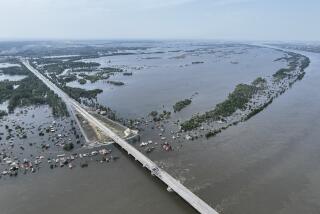Danube’s Wild Delta Saved by Uprising
- Share via
TULCEA, Romania — The overthrow of Romanian dictator Nicolae Ceausescu has averted the destruction of one of Europe’s last unspoiled wildernesses, the Danube delta.
At this time of year the delta, which covers about 1,660 square miles, is a bleak and gray expanse of sodden marshland and lagoons punctuated by unique oak forests.
In the summer, however, it comes alive with huge flocks of migratory birds, ranging from Dalmatian pelicans to Caspian terns that nest there.
Ceausescu wanted to change that. Among the many grandiose plans he had for Romania was to drain the delta and transform it into fields of wheat and corn, using huge amounts of fertilizer.
“Ceausescu personally plotted the destruction of the delta,” said Ananie Ivanov, chairman of the government ecology commission in the Danube port of Tulcea, gateway to the delta.
“He planned to go ahead with the destruction as fast as possible but now his plans have been abandoned.”
Ceausescu, overthrown and executed in a popular uprising in December, also wanted large areas of the delta planted with figs. Why, nobody knows; figs do not grow well in the area.
“After his initiative to plant figs was announced, fig trees were planted especially for him,” Ivanov recalled. “They were watered for the occasion, but after that everyone forgot about them.”
Alexandru Rosu, professor of geography at Bucharest University and vice president of the recently founded Ecology Movement of Romania, said 20% of the delta had already been destroyed, but he was confident that the rest could be saved.
He said a comprehensive conservation strategy was being formulated for the delta that would include plans to promote tourism, fishing and hunting under strict controls so as not to disturb the area’s unique ecology.
The plan must also resolve another problem--how to control one of the main industries in the delta, the harvesting of reeds for papermaking. Rosu said it was not feasible to ban the cutting of reeds entirely, but it was necessary to place strict controls on the industry or the delta would be ruined.
He said the area was seriously polluted with fertilizers and other chemicals, although this was not entirely Romania’s fault. On its way to the Black Sea the Danube runs through eight countries, all of which have tended to use it as a sewer.
Rosu, who suggests an international body be formed to tackle the problem, said that environmental safeguards hardly existed under Ceausescu, except on paper.
“There were controls but fines were low,” he said. “The most important thing was exports and in places where there were (anti-pollution) filters, factories did not use them because of the energy crisis.”
Ceausescu geared production almost exclusively to exports and ordered Draconian cuts in energy consumption as part of his obsession with wiping out the country’s $10-billion debt.
Local officials said a bauxite smelter and ferrous metals plant in Tulcea caused serious air pollution, as did a sulfur factory in the Soviet border town of Izmail, 20 miles away.
“We pollute them and they pollute us in their turn,” said Dorian Dumitriu, secretary of the Tulcea branch of the Ecology Movement, who added that local ecologists now were making contact with their Soviet counterparts to try to tackle the problem.
Ceausescu’s attitude to ecological problems was highlighted last November when Romania blocked a European agreement on the environment, saying it constituted unwarranted interference in its internal affairs.
It ignored last-minute appeals from the Soviet Union at a conference in Sofia and was the only country to refuse to endorse the pact, thus blocking final agreement on the rights of the individual to a say in environmental affairs.
Officials close to the new government admit that its environmental policies have not yet been worked out in any detail. But they are adamant that Ceausescu’s total disregard for the environment is a thing of the past.
More to Read
Sign up for Essential California
The most important California stories and recommendations in your inbox every morning.
You may occasionally receive promotional content from the Los Angeles Times.













